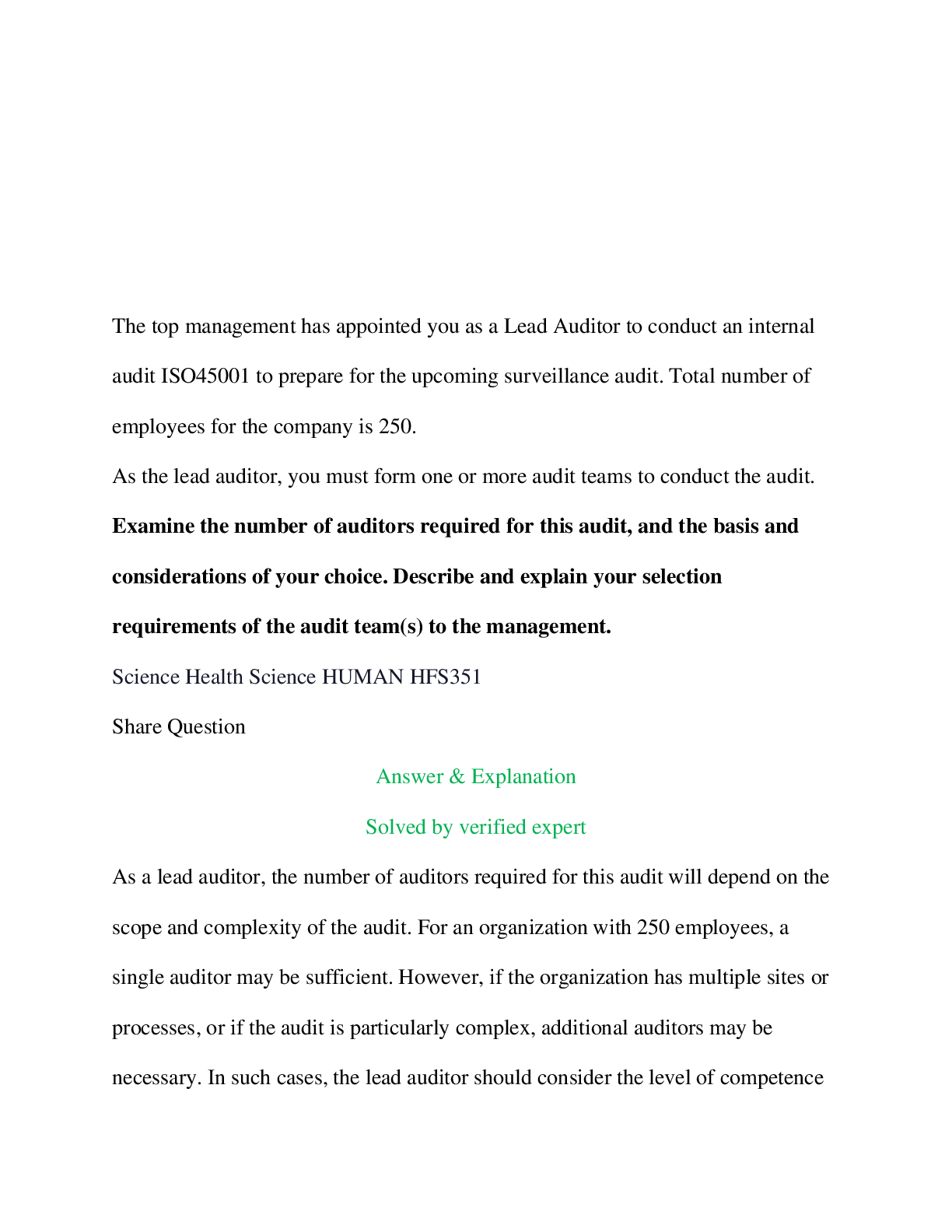BioChemistry > QUESTIONS & ANSWERS > LIFE 120 Midterm 2 Questions and Answers (Study Guide) Complete Guide to Prepare for Exams. (All)
LIFE 120 Midterm 2 Questions and Answers (Study Guide) Complete Guide to Prepare for Exams.
Document Content and Description Below
Chapter 6 – Metabolism 1. Which of these is exhibiting kinetic energy? a. an archer with a flexed bow b. the high-energy phosphate bonds of a molecule of ATP c. a rock on a mountain ledge d. a ... person sitting on a couch while watching TV e. a space station orbiting Earth 2. "Conservation of energy" refers to the fact that _____. a. if you conserve energy you will not be as tired b. the net amount of disorder is always increasing c. no chemical reaction is 100 percent efficient d. energy cannot be created or destroyed but can be converted from one form to another e. the entropy of the universe is always increasing 3. Chemical energy is a form of _____ energy. a. kinetic b. motion c. heat d. entropic e. potential 4. In your body, what process converts the chemical energy found in glucose into the chemical energy found in ATP? a. anabolism b. digestion c. cellular respiration d. potentiation e. redox 5. Which of these are by-products of cellular respiration? a. heat, carbon dioxide, and water b. ATP, carbon dioxide, and water c. carbon dioxide and water d. ATP and carbon dioxide e. glucose, carbon dioxide, and water 6. Select the highest energy form of adenosine from the following images. a. - Adenosine triphosphate (ATP) is the high-energy form of adenosine because it contains the most phosphate groups (three). This molecule fuels many different endergonic (energy-requiring) enzymatic processes in biological organisms. ATP molecules diffuse or are transported to the place where the energy is needed and deliver chemical energy from the breaking of their phosphate bonds. 7. Which part of the adenosine triphosphate molecule is released when it is hydrolyzed to provide energy for biological reactions? a. α -phosphate (the phosphate closest to ribose) b. β-phosphate (the middle phosphate) c. γ-phosphate (the terminal phosphate) d. adenine group e. ribose sugar 8. Which of these is ATP? a. 9. What type of reaction breaks the bonds that join the phosphate groups in an ATP molecule? a. hydrolysis b. dehydration synthesis c. entropic d. dehydration decomposition e. anabolism 10. In this reaction _____. a. the products have less potential energy than the reactants b. the products have been rearranged to form reactants c. entropy has decreased d. CD is a product e. AC is a reactant 11. In this reaction _____. a. the chemical energy of the products is greater than that of the reactants b. heat has been released to the environment c. entropy has decreased d. disorder has decreased e. the kinetic energy of the reactants is less than that of the products 12. The following reaction A --> B + C + heat is a(n) _____ reaction. a. anabolic b. dehydration synthesis c. endergonic d. Exergonic (heat has been release) e. exchange 13. A(n) _____ reaction occurs spontaneously. a. b. anabolic c. Exergonic (In exergonic reactions the products have less potential energy than the reactants.) d. endergonic e. kinetic f. chemical 14. Which of these reactions requires a net input of energy from its surroundings? a. ATP --> ADP + P b. catabolic c. exergonic d. endergonic e. hydrolysis 15. In cells, what is usually the immediate source of energy for an endergonic reaction? a. ATP b. ADP c. glucose d. sugar e. as spontaneous reactions, endergonic reactions do not need an addition of energy 16. The reaction ADP + P --> ATP is a(n) _____ reaction. a. chemical b. spontaneous c. exergonic d. hydrolysis e. endergonic 17. The energy for an endergonic reaction comes from a(n) _____ reaction. a. anabolic b. ADP + P --> ATP c. glucose + glucose --> maltose d. exergonic e. synthesis 18. What is the fate of the phosphate group that is removed when ATP is converted to ADP? a. It is used to convert an ATP into an AQP. b. It is acquired by a reactant in a spontaneous reaction. c. It is acquired by a reactant in an exergonic reaction. d. It is broken down into one phosphorus and four oxygen atoms. e. It is acquired by a reactant in an endergonic reaction. 19. This graph illustrates a(n) _____ reaction. a. exergonic b. hydrolysis c. catabolic d. endergonic e. spontaneous 20. Select the INCORRECT association. a. potential energy ... positional energy b. exergonic ... spontaneous c. kinetic energy ... motion d. exergonic ... uphill e. enzyme ... protein 21. What is energy coupling? a. a barrier to the initiation of a reaction b. the use of energy released from an exergonic reaction to drive an endergonic reaction c. a description of the energetic relationship between the reactants and products in an exergonic reaction d. the use of an enzyme to reduce EA e. the hydrolysis of ATP to ADP + P 22.In general, enzymes are what kinds of molecules? a. carbohydrates b. nucleic acids c. lipids d. minerals e. proteins 23.Enzymes work by _____. a. reducing EA b. decreasing the potential energy difference between reactant and product c. adding energy to a reaction d. adding a phosphate group to a reactant e. increasing the potential energy difference between reactant and product 24.An enzyme _____. a. increases the EA of a reaction b. is a source of energy for endergonic reactions c. is an organic catalyst d. can bind to nearly any molecule e. is a inorganic catalyst 25.What name is given to the reactants in an enzymatically catalyzed reaction? a. substrate b. reactors c. active sites d. products e. EA 26.As a result of its involvement in a reaction, an enzyme _____. a. loses energy b. permanently alters its shape. c. loses a phosphate group d. is used up e. is unchanged 27.What is the correct label for "A"? a. enzyme energy b. ATP c. substrate energy d. energy of activation e. uphill 28. a. (lowest reaction rate) Uncatalyzed reaction reaction catalyzed by enzyme A reaction catalyzed by enzyme B (highest reaction rate) 29. Filling the blank - An enzyme is denatured when it loses its native conformation and its biological activity. - An enzyme is considered a catalyst because it speeds up chemical reactions without being used up. - An enzyme is considered specific because of its ability to recognize the shape of a particular molecule. - A cofactor, such as vitamin, binds to an enzyme and plays a role in catalysis. - When properly aligned, the enzyme and substrate form an enzyme-substrate (ES) complex. - A substrate binds to an enzyme that the active site, where the reaction occurs. - In a catalyzed reaction a reactant is often called a substrate. 30.Which of the following statements is most likely to be true in the case of the feedback-regulated enzymatic pathway shown? a. P0 binds E4 and activates it. b. P2 binds E2 and activates it. c. P4 binds E1 and deactivates it. d. P3 binds E2 and activates it e. P4 binds E3 and deactivates it. 31.In which region does the reaction rate remain constant? Region C 32.In which region is the enzyme saturated with substrate? Region C 33.Consider a situation in which the enzyme is operating at optimum temperature and pH, and has been saturated with substrate. What is your best option for increasing the rate of the reaction? a. Increase the pH. b. Increase the temperature. c. Increase the enzyme concentration. d. Increase the substrate concentration. 34.Fill in the blank a. A competitive inhibitor has a structure that is so similar to the substrate that it can bond to the enzyme just like the substrate. b. A noncompetitive inhibitor binds to a site on the enzyme that is not the active site. c. Usually, an irreversible inhibitor forms a covalent bond with an amino acid side group within the active site, which prevents the substrate from entering the active site or prevents catalytic activity. d. The competitive inhibitor competes with the substrate for the active site on the enzyme. e. When the noncompetitive inhibitor is bonded to the enzyme, the shape of the enzyme is distorted. f. Enzyme inhibitors disrupt normal interactions between an enzyme and its substrate. 35.You have added an irreversible inhibitor to a sample of enzyme and substrate. At this point, the reaction has stopped completely. What can you do to regain the activity of the enzyme? a. Removing the irreversible inhibitor should get the reaction working again. b. The enzyme is inactive at this point. New enzyme must be added to regain enzyme activity. c. Adding more substrate will increase the rate of reaction. d. Adding more inhibitor should get the reaction up to speed again. 36.You have an enzymatic reaction proceeding at the optimum pH and optimum temperature. You add a competitive inhibitor to the reaction and notice that the reaction slows down. What can you do to speed the reaction up again? a. Add more inhibitor to speed up the reaction. b. Add more substrate; it will outcompete the inhibitor and increase the reaction rate. c. Increase the temperature. d. Increase the pH. 37.The Haber process is typically carried out at a temperature of approximately 500∘C. What would happen to the rate of the forward reaction if the temperature were lowered to 100∘C? - The reaction rate would decrease 38. What would happen to the rate of the forward reaction if the concentration of nitrogen were decreased? - The reaction rate would decrease 39.Which of the following would increase the rate of the reverse reaction? a. increasing the concentration of ammonia b. decreasing the temperature c. increasing the concentration of nitrogen 40.What will happen to the rates of the forward and reverse reactions when a catalyst is added? a. Forward rate increases; reverse rate decreases. b. Both forward and reverse rates increase. c. Both forward and reverse rates decrease. d. Forward rate decreases; reverse rate increases. [Show More]
Last updated: 1 year ago
Preview 1 out of 120 pages
Instant download
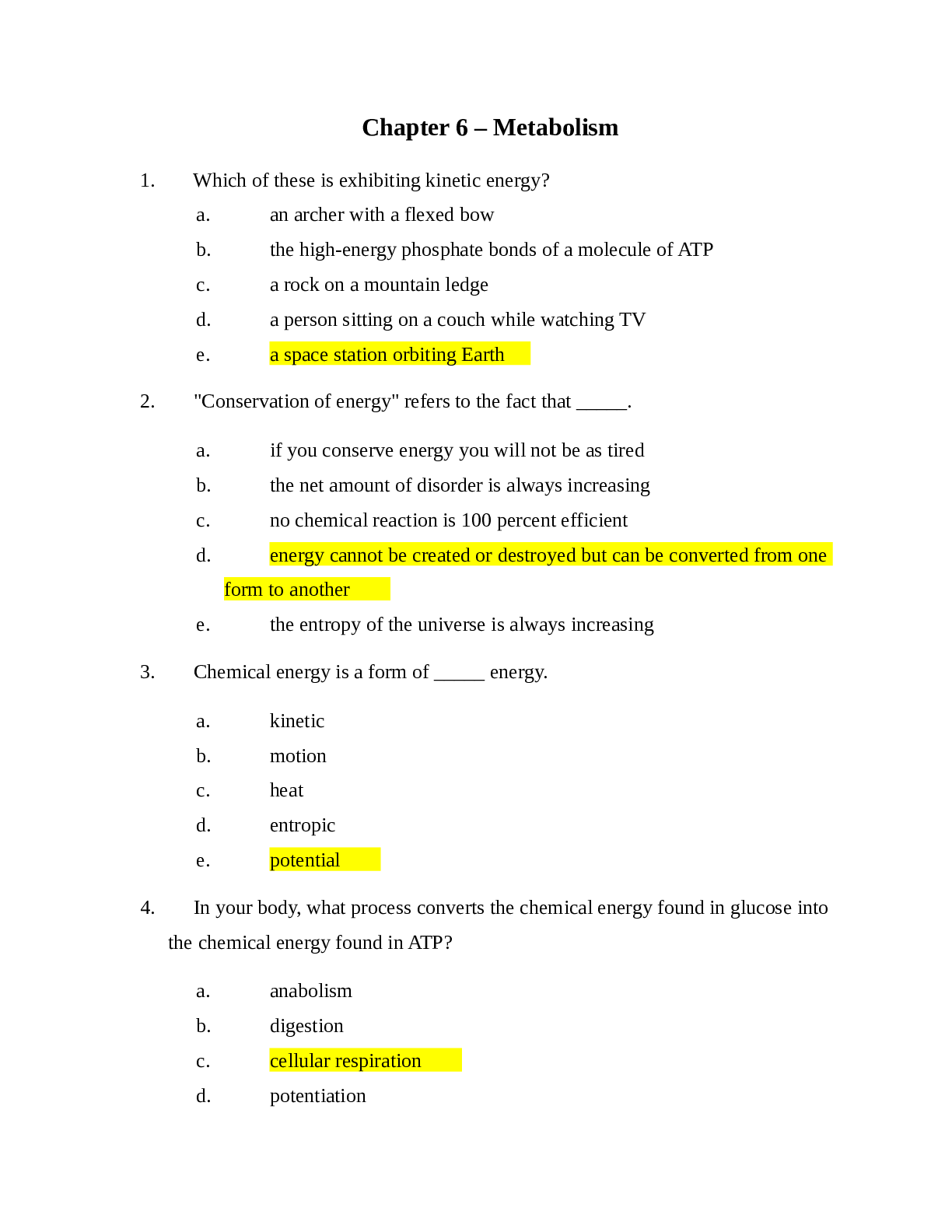
Buy this document to get the full access instantly
Instant Download Access after purchase
Add to cartInstant download
Reviews( 0 )
Document information
Connected school, study & course
About the document
Uploaded On
Apr 29, 2021
Number of pages
120
Written in
Additional information
This document has been written for:
Uploaded
Apr 29, 2021
Downloads
0
Views
43

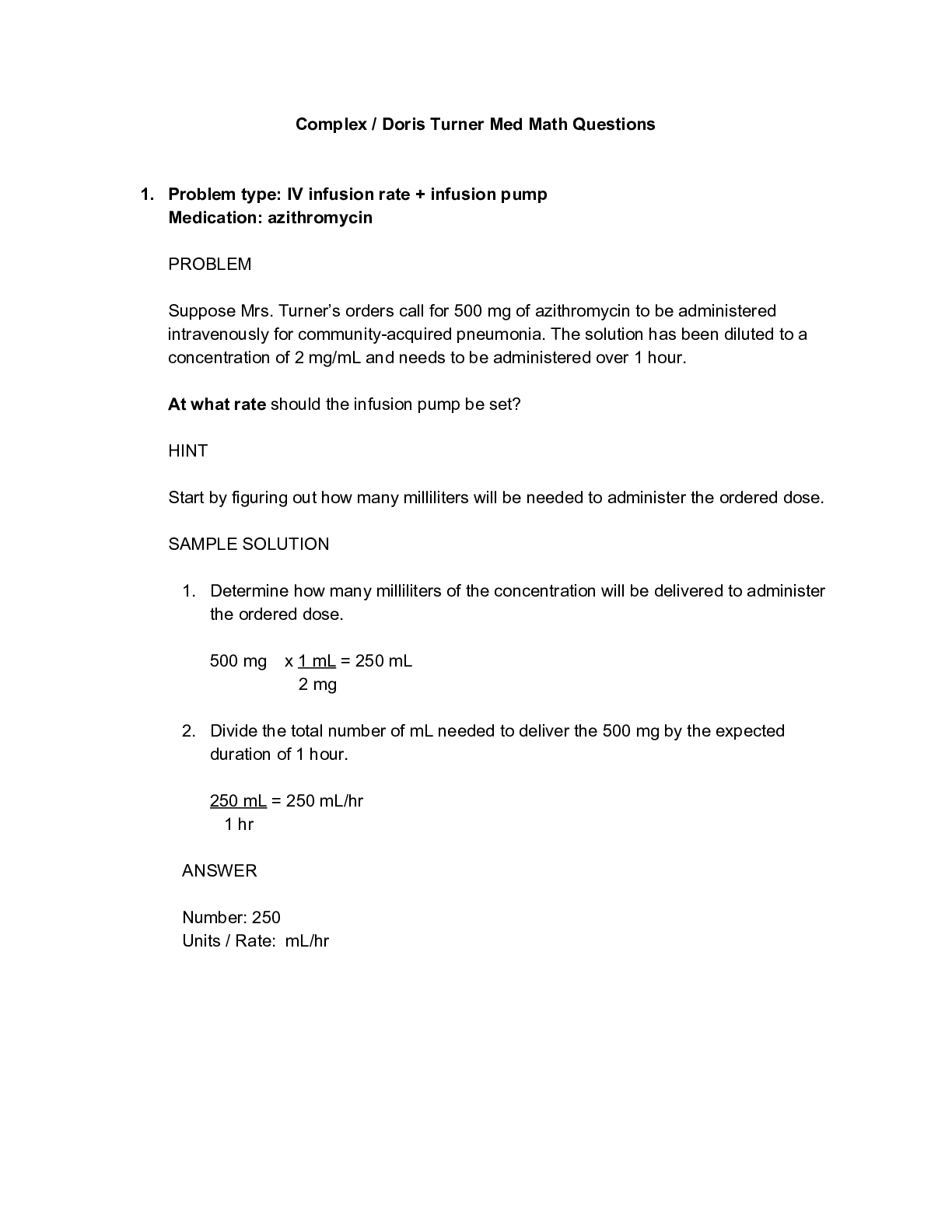





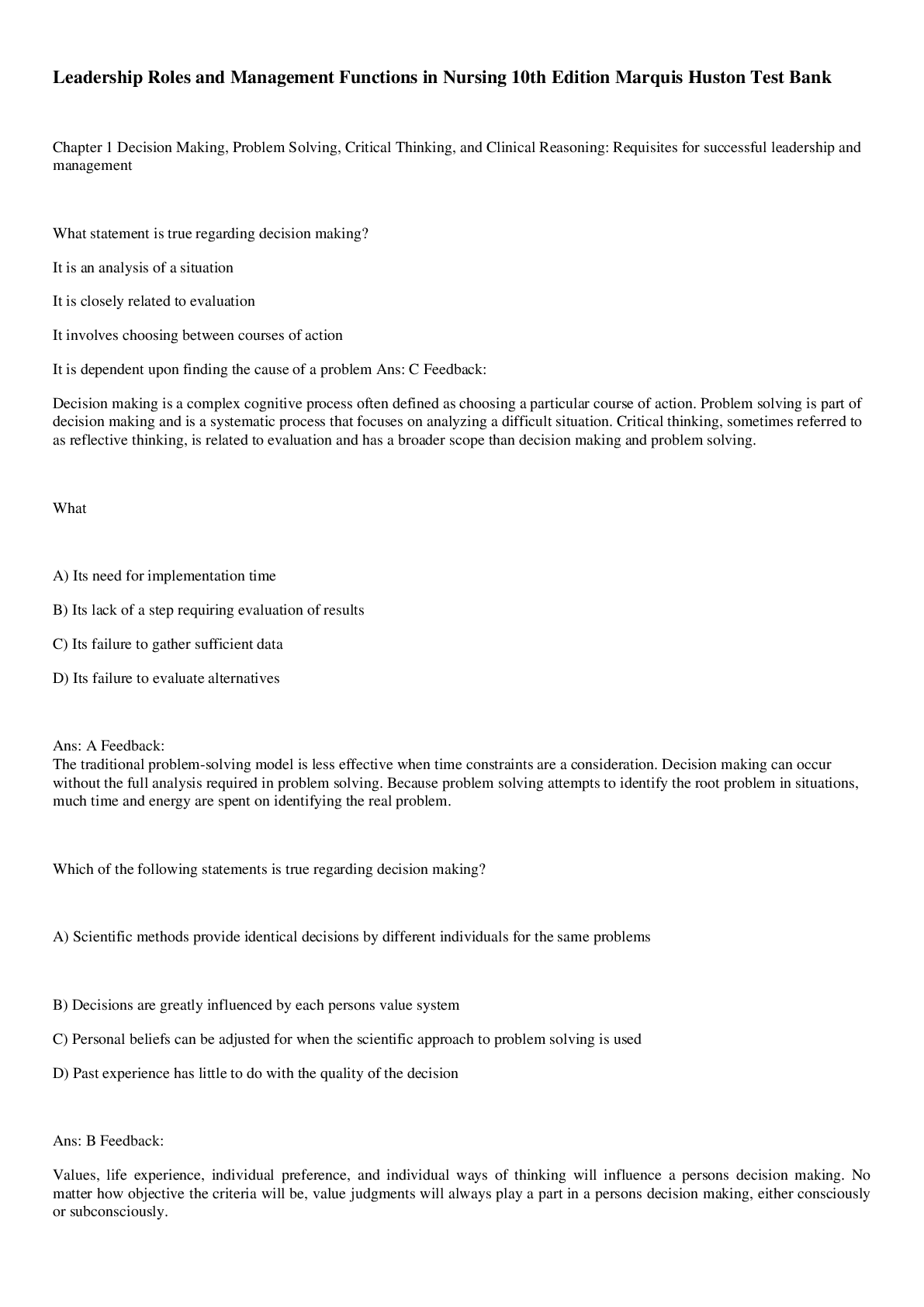


 (1).png)



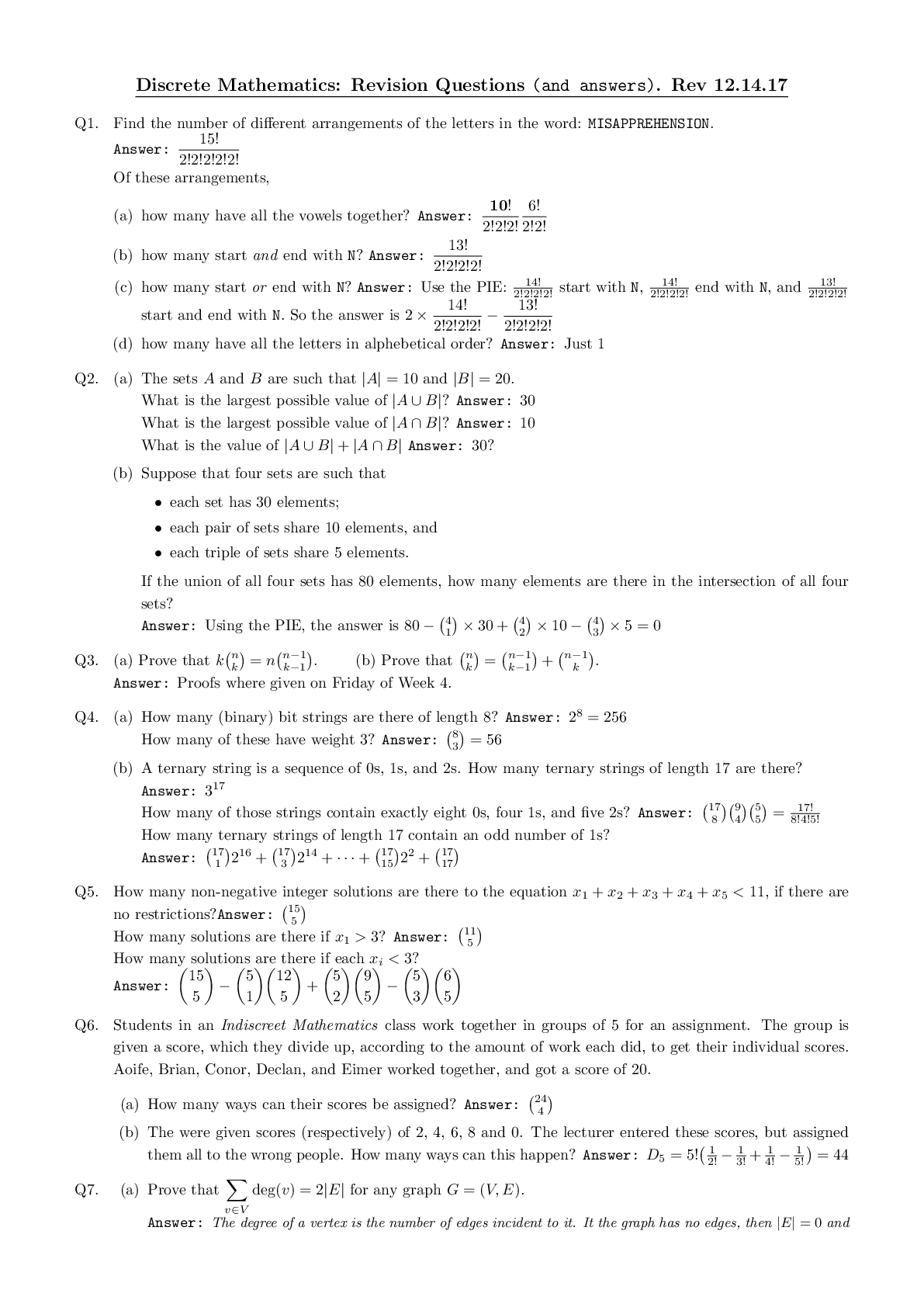

.png)
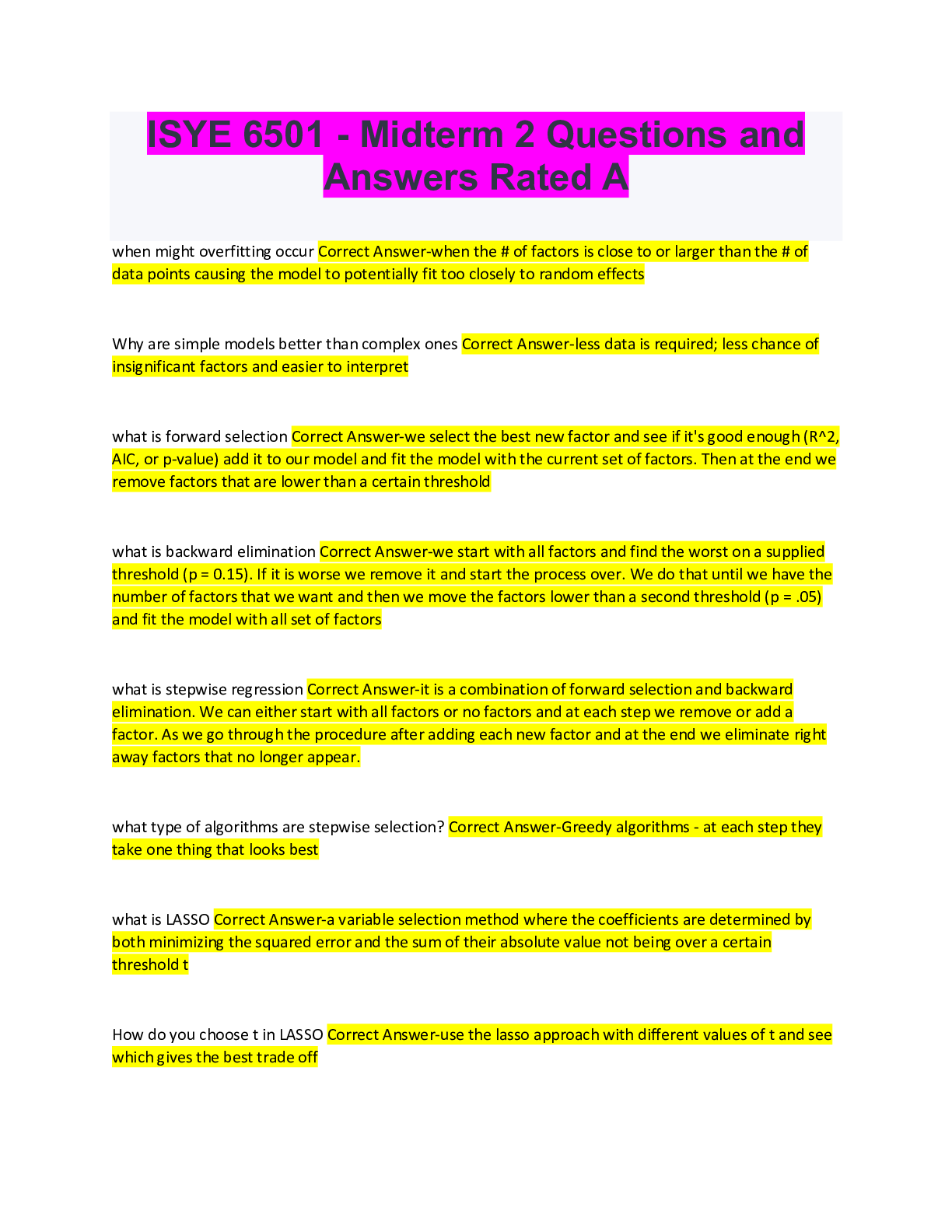
.png)
.png)

